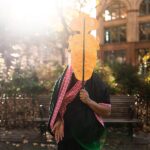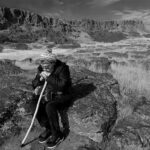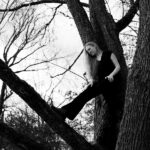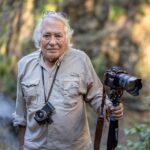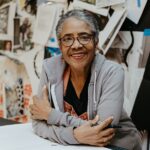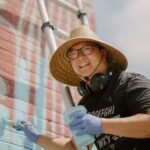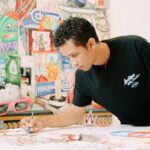Resilience
Written by Kate Gray; Photographed by Joe Cantrell
With eyes sparkling like sun on water, Lillian Pitt will tell you, “It was love at first touch.” That’s how she describes the moment she first put her hands in clay, “touching it, feeling it, smelling it, in all its stages, from moisture to dryness to fire.” She had never felt any connection as powerful, and hasn’t since.
Because of her bad back, Lillian couldn’t throw pots on a wheel, and she giggles when she says she couldn’t make mug handles. But much like a river, she carved a way around this obstacle. She hand-built her clay pieces, and started with masks: a Coastal, a Southwest, and an Alaskan mask. Quickly, Lillian realized she didn’t want to appropriate another culture’s images—but she didn’t know her own. Both her parents survived boarding schools designed to eradicate indigenous culture; their experiences may explain why they didn’t talk much about their ancestors. She’d moved to Portland the day after high school graduation, but she was born and raised on the Warm Springs Reservation. Lillian thought her family had always lived there.
At age thirty-six, Lillian returned to Warm Springs to consult her elders, “Who am I? Who are my people, and where are we from?” They told her she was from the mid-Columbia Gorge, her parents’ families from villages near Celilo Falls, the traditional center for fishing and trading in the Pacific Northwest. Her people had been there for thousands of years—until 1855, when the government forced them onto reservations in Yakima and Warm Springs.
At the same time, Lillian had been seeing an image of a woman with huge lidless eyes; her elders told her to go see Tsagaglalal, or She Who Watches, the petroglyph/pictograph in Columbia Hills State Park. Tsagaglalal had been her people’s leader, a chief who was turned into a rock by Coyote so she could watch over her people and the river forever. Two elders guided Lillian along the rocky ¾-mile trail. When she saw Tsagaglalal, she felt, “I had been found, I found myself.” Lillian describes herself as “wimpy,” but says the experience gave her “the power to stand on my own two feet and not take grief from anyone.”
Lillian realized that She Who Watches watches over her great-grandmother, whose village was submerged when the Dalles dam closed in 1957 and the river rose. It’s not surprising that Lillian connected to Mother Earth and her people through clay, because the soil along the Columbia River is dense with it. There, her hands touched her history.
From that day forward, Lillian knew her purpose: to honor her ancestors with her art, to serve her community.
You can recognize Lillian’s work when you see it. Characteristically, the faces of her masks have large almond-eyes, elegant and long noses, and a small mouth, the lips of which are shaped in an O. The story behind the faces is one Lillian heard as a child. “[The Steahah or Stick Indians] lived in the high hills or mountains. We were told that if we misbehaved or left our hair uncombed, the Steahah would steal us from beneath our covers at night, and we would never be seen again. I tried to be a good kid, especially when we traveled to the huckleberry patches in the hills. Steahah would whistle to guide a good person to safety if lost in the woods, and would lead a bad person deeper into the forest.” Most of her masks have the mouth of the whistler.
Continue Reading
When she arrived in Portland in 1962, Lillian worked as a beautician, but her bad back sent her searching for new work. At Mt. Hood Community College, she enrolled in the Mental Health and Human Services program. “I found out about myself. I’m a real person, with valid feelings and emotions, and I didn’t have to quiet myself as Mom always said.” She gained skills to be a keeper and conveyor of stories. She also took her first ceramics class and has been “playing with clay,” as she describes her art, ever since.
In addition to masks, Lillian makes jewelry, sculptures, prints, and installations. She works in glass, bronze, and found objects, like scraps of leather and cloth, bones, rusted metal, and feathers. You’ll find her masks in collections (the biggest is at Fort Vancouver), and at a Portland TriMet stop; an installation inside the Lake Oswego City Hall; animal masks for kids at a pocket park in Portland; and other works throughout the country and the world.
Some of her favorite pieces are early works, like the “Mohalla Spider Woman” mask, and her In Conflict and Nature series, which represented physical, emotional, and spiritual transformation. Carving so many hard clay forms damaged her hands, so she created her own tools from earth, sticks and rocks. The In Conflict masks are asymmetrical, one side smooth and seemingly swollen, the other side scarred, the mouths half-formed, the lips torn. “I began using shells to make repeat patterns by pressing or rolling them across half the face of my pieces. Gently working with objects of nature in the soft clay became a healing meditation.”
Barry Lopez, the late nature writer who was a good friend of Lillian’s, wrote, “One of the hardest things to hold together in modern American culture—a rice-paper house in a hurricane—is a community founded in memory, in imagination, in moral relations with the land.” Lopez used to bring Lillian sticks gnawed by beavers, which she worked into her sculptures. He taught her it was all right to be “wimpy,” as she still describes herself. Before a 2021 exhibit in Hood River, where she knew the residents had been “resistant” to native fishermen, she wanted to empower the local community rather than shame them. She created sculptures of traditional fishing tools so they could hold and value what they had once disparaged. You might consider this gentle way of educating a kindness, but with a shake of her head, she says, “wimpy.”
Lillian admits she has worked “very hard” to get where she is today, but she generously gives time, counsel, and credit to others. She is proud of her family: a brother coordinates Oregon’s salmon management task force; a sister was a drug and alcohol counselor; and many nieces and nephews are shaping Oregon’s future, including Elizabeth Woody, her niece and a former Oregon Poet Laureate, who directs the Warm Springs Museum.
“Because my life has been enriched by so many good people,” Lillian says, “I picture the Stick Indians I make whistling people to good fortune and wellbeing.”
At eighty years old, Lillian has stopped saying she’s going to retire. Instead, she says she’ll slow down. However, this year she’s been commissioned to create three public art projects. She’s doing a six-hour Zoom interview with the Smithsonian’s National Museum of the American Indian. Looking up, she adds, “I guess I have a lot to say about my ancestors and Mother Earth and roots and berries and salmon.”
Don Stastny, the architect who worked with Lillian to design the Portland State Native American Center, describes her as a “guardian of the past…and a visionary for the future.” You can see it in a huge Möbius strip in a city hall or a land bridge along the Columbia River or tiny masks pinned on scarves or silver rings carved with Tsagaglalal’s likeness or glass masks with a whistler’s lips. Lillian Pitt serves as a prism through which the light of the past filters and spreads into a brilliant future.











